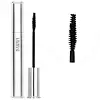Isamaya Beauty Lash Lengthening Mascara Versus Freck Lashrocket Mascara with Lash Enhancing Peptides
What's inside
What's inside
 Key Ingredients
Key Ingredients

 Benefits
Benefits

 Concerns
Concerns

 Ingredients Side-by-side
Ingredients Side-by-side

Water
Skin ConditioningCandelilla Cera
EmollientHelianthus Annuus Seed Wax
Skin ConditioningPropanediol
SolventPullulan
Glycerin
HumectantCopernicia Cerifera Cera
EmollientStearic Acid
CleansingPolyglyceryl-3 Rice Branate
EmulsifyingPalmitic Acid
EmollientCaprylyl Glycol
EmollientSodium Hydroxide
BufferingPhenoxyethanol
PreservativeSodium Dehydroacetate
PreservativeHexylene Glycol
Emulsifying1,2-Hexanediol
Skin ConditioningLarix Europaea Wood Extract
HumectantPhyllanthus Emblica Fruit Extract
HumectantSodium Metabisulfite
AntioxidantBenzoic Acid
MaskingMyristoyl Pentapeptide-17
Skin ConditioningSodium Benzoate
MaskingBenzyl Alcohol
PerfumingCamellia Sinensis Leaf Extract
AntimicrobialZinc Chloride
AntimicrobialCI 77499
Cosmetic ColorantCI 77491
Cosmetic ColorantCI 77492
Cosmetic ColorantWater, Candelilla Cera, Helianthus Annuus Seed Wax, Propanediol, Pullulan, Glycerin, Copernicia Cerifera Cera, Stearic Acid, Polyglyceryl-3 Rice Branate, Palmitic Acid, Caprylyl Glycol, Sodium Hydroxide, Phenoxyethanol, Sodium Dehydroacetate, Hexylene Glycol, 1,2-Hexanediol, Larix Europaea Wood Extract, Phyllanthus Emblica Fruit Extract, Sodium Metabisulfite, Benzoic Acid, Myristoyl Pentapeptide-17, Sodium Benzoate, Benzyl Alcohol, Camellia Sinensis Leaf Extract, Zinc Chloride, CI 77499, CI 77491, CI 77492
Water
Skin ConditioningButylene Glycol
HumectantGlycerin
HumectantVp/Eicosene Copolymer
Stearic Acid
CleansingBehenyl Behenate
EmollientCopernicia Cerifera Wax
Glyceryl Stearate
EmollientPolyhydroxystearic Acid
EmulsifyingPolyisobutene
Euphorbia Cerifera Wax
Panthenol
Skin ConditioningBiotinoyl Tripeptide-1
Acetyl Tetrapeptide-3
Skin ProtectingTrifolium Pratense Flower Extract
AstringentSodium Hyaluronate
HumectantTocopheryl Acetate
AntioxidantAcacia Senegal Gum
Masking1,2-Hexanediol
Skin ConditioningCaprylyl Glycol
EmollientHydroxyacetophenone
AntioxidantXanthan Gum
EmulsifyingTrisodium Ethylenediamine Disuccinate
Dextran
Potassium Hydroxide
BufferingCI 77499
Cosmetic ColorantWater, Butylene Glycol, Glycerin, Vp/Eicosene Copolymer, Stearic Acid, Behenyl Behenate, Copernicia Cerifera Wax, Glyceryl Stearate, Polyhydroxystearic Acid, Polyisobutene, Euphorbia Cerifera Wax, Panthenol, Biotinoyl Tripeptide-1, Acetyl Tetrapeptide-3, Trifolium Pratense Flower Extract, Sodium Hyaluronate, Tocopheryl Acetate, Acacia Senegal Gum, 1,2-Hexanediol, Caprylyl Glycol, Hydroxyacetophenone, Xanthan Gum, Trisodium Ethylenediamine Disuccinate, Dextran, Potassium Hydroxide, CI 77499
Ingredients Explained
These ingredients are found in both products.
Ingredients higher up in an ingredient list are typically present in a larger amount.
1,2-Hexanediol is a synthetic liquid and another multi-functional powerhouse.
It is a:
- Humectant, drawing moisture into the skin
- Emollient, helping to soften skin
- Solvent, dispersing and stabilizing formulas
- Preservative booster, enhancing the antimicrobial activity of other preservatives
Caprylyl Glycol is a humectant and emollient, meaning it attracts and preserves moisture.
It is a common ingredient in many products, especially those designed to hydrate skin. The primary benefits are retaining moisture, skin softening, and promoting a healthy skin barrier.
Though Caprylyl Glycol is an alcohol derived from fatty acids, it is not the kind that can dry out skin.
This ingredient is also used as a preservative to extend the life of products. It has slight antimicrobial properties.
Learn more about Caprylyl GlycolCi 77499 is also hydrated iron III oxide. It is created from mixing red and black iron oxides. This helps give shades of darkness to a product.
Iron III oxides are classified as inorganic chemicals for coloring.
Glycerin is already naturally found in your skin. It helps moisturize and protect your skin.
A study from 2016 found glycerin to be more effective as a humectant than AHAs and hyaluronic acid.
As a humectant, it helps the skin stay hydrated by pulling moisture to your skin. The low molecular weight of glycerin allows it to pull moisture into the deeper layers of your skin.
Hydrated skin improves your skin barrier; Your skin barrier helps protect against irritants and bacteria.
Glycerin has also been found to have antimicrobial and antiviral properties. Due to these properties, glycerin is often used in wound and burn treatments.
In cosmetics, glycerin is usually derived from plants such as soybean or palm. However, it can also be sourced from animals, such as tallow or animal fat.
This ingredient is organic, colorless, odorless, and non-toxic.
Glycerin is the name for this ingredient in American English. British English uses Glycerol/Glycerine.
Learn more about GlycerinStearic Acid is a fatty acid. It is an emollient, emulsifier, and texture enhancer.
As an emollient, stearic acid helps soften skin. It aids the skin's protective barrier by preventing water loss. It also provides a gentle cleansing effect without stripping away natural oils.
Stearic acid may also be used to enhance the texture of products. It can add volume and stabilize ingredients such as water and oil. This can help water and oil ingredients from separating.
Sources of stearic acid include animal or vegetable fats/oils such as coconut or shea. It can be naturally found in butter, cocoa butter, shea butter, vegetable fats, and animal tallow.
This ingredient may not be Malassezia folliculitis, or fungal-acne safe.
Learn more about Stearic AcidWater. It's the most common cosmetic ingredient of all. You'll usually see it at the top of ingredient lists, meaning that it makes up the largest part of the product.
So why is it so popular? Water most often acts as a solvent - this means that it helps dissolve other ingredients into the formulation.
You'll also recognize water as that liquid we all need to stay alive. If you see this, drink a glass of water. Stay hydrated!
Learn more about Water